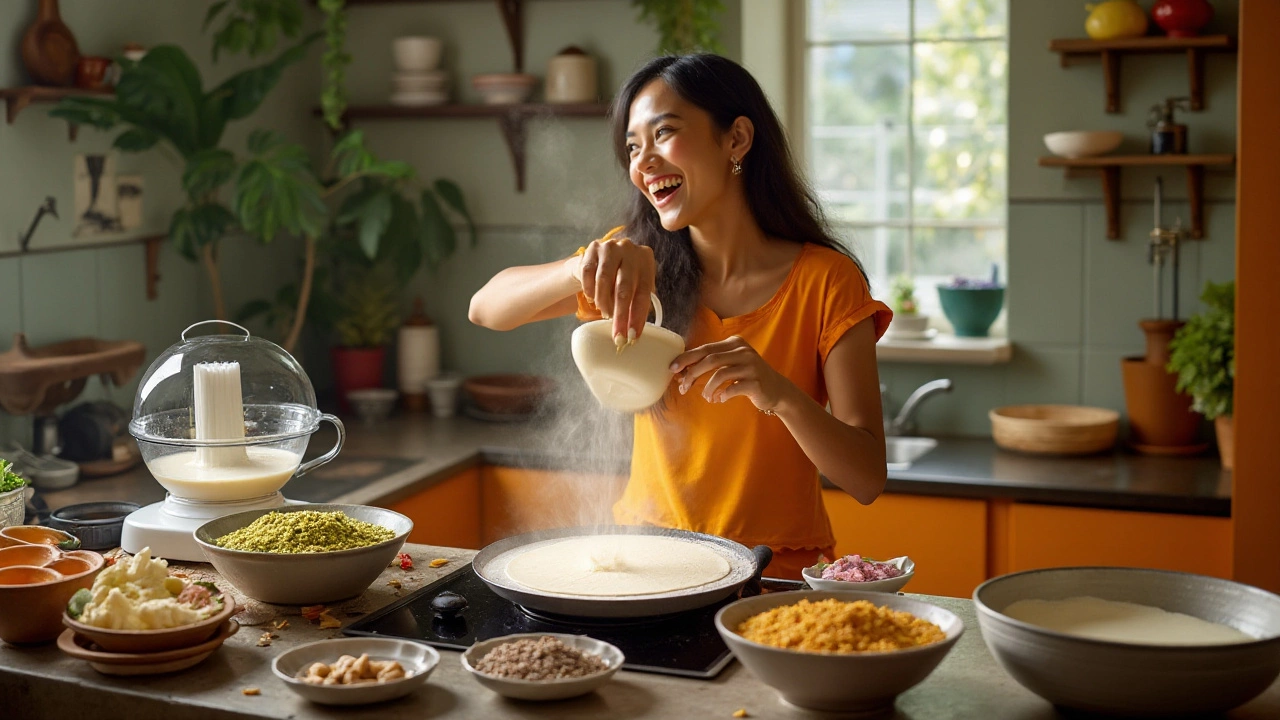Instant Dosa: Fast, Crispy, and Delicious
When working with Instant Dosa, a ready‑to‑cook version of the classic South Indian crepe made from a pre‑fermented rice‑and‑urad batter. Also known as ready‑made dosa mix, it lets you serve hot, crisp dosas in under ten minutes without the usual overnight soak. The idea behind instant dosa is simple: eliminate the long fermentation step while keeping the texture and flavor that people love. If you’ve ever stared at a bowl of batter that refuses to rise, you’ll appreciate the shortcuts that reliable shortcuts provide.
Key Ingredients That Make It Work
The backbone of any good dosa is Urad Dal, split black gram that gives the batter its airy structure and subtle nuttiness. Traditionally it’s soaked for 6‑8 hours, ground, and blended with rice. For an instant version, many brands use pre‑ground urad powder, but the same principle applies – you still need the protein‑rich legume to trap air bubbles. Rice flour replaces the soaked rice, providing the carbohydrate base that crisps up on the hot griddle. The combination of these two gives the dosa its signature light‑yet‑crunchy bite.
Another secret weapon is Baking Soda, a leavening agent that creates quick carbon‑dioxide bubbles during cooking. Adding a pinch at the right ratio (about ¼ teaspoon per cup of batter) speeds up the rise, mimicking the effect of natural fermentation. This is why you’ll see recipes titled “Why Add Soda to Dosa Batter?” – the soda not only saves time but also helps achieve that signature puff and crisp edge.
Temperature control is the final piece of the puzzle. Instant batter spreads best on a well‑heated non‑stick tawa or cast‑iron skillet. The surface should sizzle as soon as the batter hits it; otherwise you’ll end up with a soggy pancake. A quick test: sprinkle a few drops of water on the pan – they should dance and evaporate instantly. That’s the sweet spot for instant dosa cooking.
Because instant dosa skips the natural fermentation, flavor can feel flat. To counter that, many cooks add a splash of yogurt or a tiny squeeze of lemon juice to the batter. The acidity brightens the taste and adds a subtle tang that resembles the sour notes of a long‑fermented mix. The trick is to keep the addition minimal – you don’t want the batter to become too runny.
Once you’ve mastered the batter, serving ideas are endless. Classic accompaniments include Sambar, a lentil‑based vegetable stew seasoned with tamarind and mustard seeds. Its tangy broth pairs perfectly with the neutral dosa base. Coconut chutney, tomato chutney, and even a simple butter spread can turn a quick snack into a complete meal.
For those who love variety, the instant batter can be tweaked with herbs or spices – a pinch of cumin, chopped cilantro, or a dash of red chili flakes adds character without extra effort. You can also blend in grated carrots or spinach for a colorful, nutrient‑boosted version. All these tweaks keep the cooking time short while letting you experiment.
In short, instant dosa is a blend of smart ingredient choices, a splash of soda, and a hot pan. The technique bridges the gap between traditional South Indian breakfast rituals and today’s fast‑paced kitchens. Below you’ll find a curated list of articles that dive deeper into each of these aspects – from the science of soda in batter to the myth‑busting facts about soaking urad dal overnight. Ready to flip your first instant dosa? Keep reading for the step‑by‑step guides, troubleshooting tips, and flavor ideas that will turn your kitchen into a quick‑serve dosa haven.

Quick Fix for Making Dosa with Unfermented Batter
Making dosa without fermented batter can seem difficult, but it is absolutely doable with the right techniques. This guide explores simple strategies for preparing delicious, crispy dosas even when the batter hasn't had time to rise. We'll dive into practical tweaks and substitutions that help achieve similar results to traditionally fermented batter. By understanding the natural ingredients and adding a touch of science, anyone can enjoy this staple Indian dish anytime.
- Chutney Recipes (13)
- General (11)
- Healthy Living (10)
- Easy Indian Recipes (9)
- Chicken Curry Recipes (9)
- Healthy Indian Snacks (8)
- Paneer Recipes (7)
- Dal Recipes (7)
- Street Food (7)
- Dosa Recipes (7)
-
Why Is There Potato in Biryani? The Real Story Behind This Tasty Twist
19 Apr 2025 -
Why Is My Homemade Paneer Crumbly? Common Culprits and Easy Fixes
2 May 2025 -
Why Indians Say ‘Tata’ Instead of ‘Bye’: Meaning, Origin & Usage
10 Oct 2025 -
Discover Healthy Indian Snacks for Guilt-Free Indulgence
3 Jan 2025 -
Understanding Dal: What Do Americans Call This Staple Ingredient?
31 Jan 2025
23.01.25
Kaia Binari
0